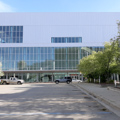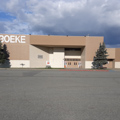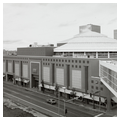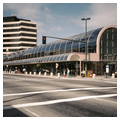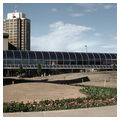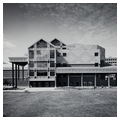In the late 1890s and early 1900s, Alaska experienced one of North America’s greatest gold rushes. But the wealth generated during the rush did not result in an appreciably richer territory. A few decades later, the territory was among one of the poorest places in the United States; it remained so even after Alaska gained statehood in 1959. But in another unpredictable twist, a generation later, Alaska had become not only the nation’s forty-ninth state but also its richest, the result of the discovery of oil in the Arctic. Until the oil strike there remained a serious question as to whether or not Alaska could ever prosper. However, by the end of the 1970s, the state collected hundreds of millions in revenue from land leases and taxes levied on some of the world’s most powerful corporations. Anchorage, the state's largest city, grew from roughly fifty thousand in 1970 to over 225,000 just twenty years later. Anchorage's rapid expansion put pressure on local leadership to invest in cultural and entertainment venues, as well as other amenities that new arrivals had come to expect.
In response, Alaska legislators and Anchorage municipal officials earmarked millions of dollars in oil revenue to upgrade the city’s parks, recreation, and cultural institutions in an effort known as Project 80s. Largely conceived of by longtime Anchorage mayor, George Sullivan, the Project 80s building boom encompassed most of the decade. Prior to the ambitious project, Anchorage still recalled its frontier days with little in the way of modern cultural outlets, improved park space, sporting venues, or convention centers. Although Sullivan was a proponent of Project 80s, much of the construction occurred under the administration of his successor, Tony Knowles. The collapse of oil prices on the global oil markets precipitated Alaska’s deepest recession and effectively marked an end to the building boom by 1986–1987 and ushered in a steep decline in the price of area real estate.
Still, the series of capital improvements that occurred throughout the 1980s shaped the city in profound ways and left an enduring social, economic, and cultural legacy. Indeed, many of Anchorage’s most significant public structures, including the expansion of the Anchorage Museum, the construction of the new Z.J. Loussac Library, William Egan A. Civic and Convention Center, the downtown performing arts center, a downtown transit center, and the George M. Sullivan Arena was built during these years and remain in use today.
The performing arts center was the first of the ambitious projects announced. The proposed center was initially designed in 1979 but finally completed in 1988. It anchored a redesigned downtown commercial and entertainment district between Fifth and Sixth Avenue, then known as the city’s “skid row,” populated with bars and adult entertainment. “I hope this is the centerpiece of the future growth of our city and the rejuvenation of the downtown area,” said architect Jeffrey Wilson.
During construction, a naming committee consisting of city leaders and community members proposed that the new performing arts center bear the name of slain civil rights leader, Martin Luther King Jr. After nine months of debate, the Assembly voted 10 to 1 in September 1986 to affix King’s name to the new venue. However, a backlash against naming the center after Martin Luther King Jr. emerged within Anchorage’s white conservative community. They felt his name did not merit attachment to a public building in the city. Several activists appealed the assembly’s decision and garnered signatures necessary to put the question before voters. In October 1987, a majority of Anchorage residents overruled the assembly and voted to remove Martin Luther King’s name from the center. Since that time, the building has been known as the Alaska Center for the Performing Arts. The controversy laid bare questions of race, the legacy of civil rights, and who deserved to have their name affixed to Anchorage’s public buildings. It also suggested that Project 80s redevelopment efforts had at their root a desire to appeal to a predominantly white and middle-class base of residents who had recently relocated to the city.
Beyond the controversy over its name, the $71 million Alaska Center for the Performing Arts was controversial for its cost and design principles. The building's critics have questioned the necessity of three separate theaters under a single roof and have suggested that it is too big for a city of Anchorage’s size. Designed by Hardy Holzman Pfeiffer Associates of New York, in association with Livingston Slone, Inc., the arts center embraced postmodern design elements with a pastiche of textures and styles, along with several gabled entrances, porticos, and arcades in the performing arts center and its connecting park. Consuming more than a city block, city planners reordered traffic patterns to accommodate its size. But as they did, the north-south thoroughfare, F Street, was cut off. This created limited access to the building and made it nearly impossible to simply drop off patrons. Adding to the confusion, the entrances were built on the wrong side of one-way streets. But regardless, few today disagree that the Performing Arts Center fails to provide Anchorage a venue for the arts and culture that would be the envy of many cities twice its size in the Lower 48.
The Anchorage Museum, located at the eastern end of downtown, also underwent renovations during the Project 80s boom. After a significant upgrade in 1973–1974, the museum then added a two-story section to its Seventh Avenue side in 1984–1986. During these years, the museum took on its familiar appearance, with its expansive oak interior, welcoming atrium, illuminated by a glass drum above the roof and glass-block windows at the rear. The atrium’s stairway leads to galleries on the second and third floor, including the newly expanded Rasmuson Wing and the Smithsonian exhibition on Alaska Native history and culture. While the Anchorage Museum remains first and foremost a space dedicated to the art, culture, and history of Alaska, it also has also served as a public gathering space. Since the renovations of the 1980s, the museum has continued to host galas, silent discos, holiday markets, and performing artists, in addition to speakers.
The centerpiece of Project 80s in regards to the business and economic development of the city might be the Egan Convention Center, named for Alaska's first governor, William A. Egan. Completed in 1983 and conveniently located in the heart of downtown on Fifth Avenue, adjacent to the Performing Arts Center, the Egan Convention Center is a modern design dominated by curved glass. The elongated structure took the place of the old Loussac Library and ensured a greater degree of foot traffic in the area. Architects and planners of the Egan Convention Center enlivened the facade with a two-story, round-arch, glass-covered lobby. That arch is repeated in the glass canopy extending over the sidewalk. The light-filled lobby, decorated in mauves, with a pink granite floor, contains public art, including a dramatic work of glass beads. There are two levels of windowless meeting rooms in the main block. On the first floor, the 20,000-square-foot Explorers Hall has a 22-foot ceiling height and can be divided into three rooms. On the lower level, the Summit Hall has a 12-foot ceiling height and can be divided into fourteen rooms. A partial mezzanine level at the east end contains administrative offices.
The Egan Convention Center played a vital role in Alaska commerce and functioned as one of the state’s primary business convention venues. However, the Dena’ina Civic and Convention Center, completed in 2008 has taken on much of the role formerly played by the Egan Center. Alongside the Dena’ina Civic and Convention Center and the Alaska Center for the Performing Arts, the Egan Convention Center fills out Anchorage’s dedicated space for trade shows, conventions, concerts, and other civic and cultural events.
While the Egan Convention Center replaced Anchorage’s aging downtown library, oil revenues allowed the city to build a bigger, more impressive public library. The new Z. J. Loussac Library, named after Zachariah Joshua Loussac, a former mayor of Anchorage from 1948-51 and a well-known businessman and philanthropist. His foundation, the Loussac Foundation, provided the money for the original public library. That library occupied the land on the 500 block of West Fifth Avenue in downtown Anchorage between 1952 and 1981 before it was razed to make way for the Egan Center.
The newer Loussac library was opened in 1986 in midtown Anchorage, about three miles from its former, downtown location. The Loussac Library is a light brown brick with concrete building. In addition to its glass-roofed entrance, the building consists of three cylinders linked together and with a square block at one end. Due to the economic decline of the mid-1980s, the library did cut back its construction budget and has received heavy criticism for the apparent flaws in its design. For instance, the library was supposed to include a parking garage that would lead into a second-level entry point to the library. To cut costs, the garage was eliminated, but the library maintained the second-level entrance. However, the stairway that led up the second-level entrance was hazardous in the winter and invited much disdain. Finally, between 2017 and 2018 the library underwent a renovation to make the entrance more accessible.
Still, the Loussac Library is an impressive building, performing a valuable service to the community. The Anchorage Assembly meets on the first floor; a public auditorium hosts speakers and events. Aside from the library’s collection of books, videos, and public computers, and classroom and meeting space, there was once an Alaska Room that housed rare manuscript collections, maps, and ephemera related to the history of Southcentral Alaska. As of 2019, the Alaska room has been repurposed to a general public gathering space, and the artifacts and material formerly held in the Alaska room have been integrated into the library’s general collections. Due to its lack of an accessible entrance, the library was initially resented by residents who felt that too much money was spent on an ill-designed building and not enough books to put in it. The cost of the renovations to the library and the decision to close the Alaska room in the more recent years have also drawn controversy. Still, the library serves as a public gathering space, hosts lectures and performances, and provides internet access for underserved members of the community.
While the performing arts center, the library, and the convention center all gestured towards the city’s civic and cultural ambitions, the Sullivan Arena signaled that Anchorage sought a place on the national stage for athletics. Completed in 1983 at a cost of $25 million, the Sullivan Arena was designed as a multi-purpose sports arena that sits just south of downtown Anchorage between two major thoroughfares, the Seward Highway and A Street. Named after Anchorage mayor, George Sullivan, the arena is a concrete structure that supports the dome and inner seats. Like other arenas around the nation that were built during the 1970s and 1908s, its design is functional and eschews flourishes and novelty. The arena was built with an ice rink and basketball court, but it has also hosted concerts, conventions, boxing and wrestling matches, and other events.
The seating capacity for the Sullivan Arena ranges between 6,500 for hockey and nearly 9,000 for concerts or wrestling matches. The arena has hosted national performing acts, but it was used mostly as the home-ice arena for the Aces, a semiprofessional hockey team that played in Anchorage between 1989–2003 as the Anchorage Aces and 2003–2017 as the Alaska Aces. It also hosted the Great Alaska Shootout, an early-season NCAA basketball tournament from 1983 to 2013. Currently, the Sullivan Arena is used sparingly. The Alaska Airlines Center, on the campus of the University of Alaska Anchorage, has become the premier arena and more typically hosts national musical acts. Yet the Sullivan Arena remains the only large-scale arena with an ice surface. In 2015, the arena received a $9 million renovation, included new seats and a scoreboard.
By the end of the 1980s, Anchorage had undergone a considerable change to its built environment. At the beginning of the decade, the city possessed only modest cultural, civic, and athletic institutions. Alaska remained a remote outpost and a place most certainly not associated with the arts and culture. But as the oil revenue began to flow, the state’s new arrival demanded the amenities found in the cities from which they came. City politicians were only too eager to oblige, and the city’s most ambitious construction boom began. By the decade’s end, downtown Anchorage would be transformed with the new addition of the Performing Arts Center, the Egan Convention Center, the Town Square Park, and a Museum that gained international acclaim. Just beyond downtown, Anchorage’s public library and new hockey arena signaled the city’s ambitions. Most of all, Project 80s represented the belief that Anchorage’s population was there to stay. The investment into these cultural and civic institutions demonstrated a population that was no longer fly-by-night, or simply here to profit handsomely from the extractive industries and immediately pull up the stakes at the earliest convenience. The 1980s bubble certainly did burst, and the state’s population indeed declined for several years. But it would, in time, bounce back. Those who stayed (as well as those who moved to Anchorage over the next generation) benefited from the bounty of cultural and entertainment options that resulted from Project 80s. In large part, Anchorage’s amenities far outpace cities of a similar size. This is the result of the wealth and foresight of city leadership at that critical moment.
To help readers understand the significance of Project 80s, it would be helpful if the essay included some demographic information about population growth and the physical state of Anchorage prior to the discovery of oil. While the essay's introduction makes it clear that the gold rush did not result in an "appreciably richer territory," it is less clear what the state of the Anchorage's parks, recreation and civic institutions were. Some general sense of, say the impact of earlier improvements might be helpful--whether these were federal, state or local. New Deal's impact in Anchorage? How about a sentence. Eisenhower Interstate program in Anchorate? This doesn't need to be details but just to convey SOME sense of development of the "civic infrastructure" before oil. The third paragraph could be expanded to include a fuller range of projects (especially transit center) since the rest of the essay focuses on the performing arts center and museum and convention center. Also, it would be useful to locate these projects within Anchorage, what area(s) was targeted for development? Was there a masterplan? George Sullivan is mentioned but were others involved? And as the discussion of the controversy over naming the performing arts center after MLK is dealt with so clearly, it would be good to mention the socioeconomic targets of Project 80s: it is notable that the oil revenue money was not being spent, for example, on affordable housing, schools etc. It would be good to be more explict about the target audiences/constituencies for these projects.
References
Richard Mauer, “Center for the Performing Arts Is Off to a Sour Start,” Anchorage Journal.
John Knowlton, “Project 80s: Anchorage Responds,” Anchorage Times, July 15, 1980, A-1, A-3.
Charles Wohlforth, From the Shores of Ship Creek: Stories of Anchorage’s First 100 Years (Anchorage: Todd Communications, 2015).
Allison Hoagland, Buildings of Alaska (New York, NY: Oxford University Press, 1995).
Writing Credits
If SAH Archipedia has been useful to you, please consider supporting it.
SAH Archipedia tells the story of the United States through its buildings, landscapes, and cities. This freely available resource empowers the public with authoritative knowledge that deepens their understanding and appreciation of the built environment. But the Society of Architectural Historians, which created SAH Archipedia with University of Virginia Press, needs your support to maintain the high-caliber research, writing, photography, cartography, editing, design, and programming that make SAH Archipedia a trusted online resource available to all who value the history of place, heritage tourism, and learning.

